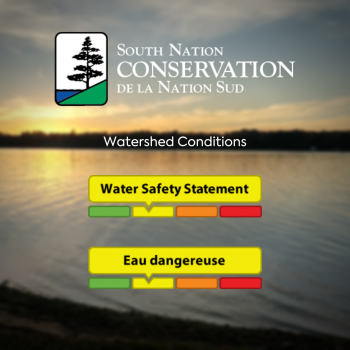This page is dedicated to providing the most current and up-to-date information regarding high water conditions. New information will appear at the top of the page.
To be added to the River Watch newsletter email list or if you have questions regarding this information, please contact Hans Werner-Mackeler, Community Emergency Management Coordinator (CEMC) at emergplan@augusta.ca.
_________________________________________________________________________________________________________________________________
Watershed Conditions: Water Safety Statement from the South Nation Conservation Authority
Weather Forecast:
Rainfall amounts are forecasted to reach up to 60 mm by early Sunday morning.
Environmental Conditions:
The South Nation River Watershed is currently in a Level 1 Low Water Condition; however, river flows are expected to increase quickly due to expected rainfall.
Risks:
Rainfall is likely to produce higher water levels and possible nuisance flooding in low-lying areas across the jurisdiction.
ACTION:
Residents are advised to exercise caution when near rivers as the forecasted weather may rapidly increase river flows and cause slippery riverbanks. Parents are encouraged to explain these dangers to their children.
Duration:
This water safety statement is in effect until Tuesday, October 19, 2021 at 5 PM or until an update has been issued.
To read the full statement, visit the South Nation Conservation Authority’s website.
Posted October 15, 2021
Low Water Status Returned to “Normal” in Rideau Valley Watershed
Watershed conditions in the Rideau Valley Watershed have returned to “Normal’ under the Ontario Low Water Response Program.
With above average rainfall amounts across the watershed over the last month, stream flows and water levels have recovered from the previous low water status and are now above average for this time of year.
To read the complete statement, visit the Rideau Valley Conservation Authority website.
Posted October 6, 2021
Watershed Conditions: Water Safety Statement from the South Nation Conservation Authority
Weather Forecast:
Environment Canada is forecasting rainfall amounts of 40 to 60 mm by early Friday morning.
Environmental Conditions:
The South Nation River Watershed is currently experiencing a minor drought (Level 1 – Low Water Condition), with river flows that are below normal for this time of year. Water flows are expected to increase over the coming days with the forecasted rainfall.
Risks:
Rainfall is likely to produce higher water levels and possible nuisance flooding in low-lying areas across the jurisdiction.
ACTION:
Residents are advised to exercise caution when near rivers as the forecasted weather may rapidly increase river flows and cause slippery riverbanks. Parents are encouraged to explain these dangers to their children.
Duration:
This water safety statement is in effect until Monday, September 27, 2021, at 5:00 PM or until an update has been issued.
SNC monitors the water levels and weather forecasts as part of the Flood Forecasting and Warning Program. Updates are provided as conditions change.
Please visit www.nation.on.ca for more information. To provide feedback with respect to changes in water related conditions please email waterwatch@nation.on.ca, post on our Facebook (/SouthNationConservation) or Twitter (@SouthNationCA).
FOR MORE INFORMATION: Katherine Watson, Water Resources Specialist – Monitoring, 1-877-984-2948, kwatson@nation.on.ca.
To read the statement, visit the South Nation Conservation Authority’s website.
Posted September 23, 2021
Watershed Conditions Statement from the Rideau Valley Conservation Authority
Environment Canada is forecasting rainfall amounts of 60 to 90 mm starting today through early Friday morning, with a few localities possibly exceeding 100 mm. The higher amounts are forecasted for the upper part of the Rideau Valley Watershed. This widespread rainfall event is due to a cold front and a moisture-laden low pressure system that will arrive from the American Midwest.
Because the Rideau Valley Watershed is currently in a “minor low water condition,” all water levels and flows are currently below normal, so significant flooding is not expected. However, this large rain event will cause all water levels and flows to increase rapidly and could cause localized flooding in small watercourses, urban areas and ditches.
The RVCA reminds the public to exercise extreme caution around all waterbodies and remind children about the dangers of playing near open water. Residents are reminded to make sure their sump pumps are in good working condition and to help reduce ponding by keeping ditches, culverts, and storm drains clear of obstructions.
This watershed conditions statement is in effect until Tuesday, September 28, 2021 at 5 PM or until an update has been issued.
To read the statement, visit the Rideau Valley Conservation Authority’s website.
Posted September 22, 2021

RIVER WATCH 2020 # 7
The attached release from the International Joint Commission indicates that the Commission has approved increased St. Lawrence River flows in January and February of 2021. Any continuation of those flows into March and beyond will require further Commission approval. However please note the qualifier highlighted in yellow.
Prepared: December 16, 2020
The International Lake Ontario- St. Lawrence River Board to Implement Strategy to Deviate from Plan 2014 this Winter
Date: December 11, 2020
The International Joint Commission (IJC) has approved the Board’s request for authority to deviate from Plan 2014, and as conditions permit, outflows from the Moses-Saunders dam on the St. Lawrence River can be increased to exceed Plan 2014 flows.
The risk of high water on Lake Ontario in 2021 is moderate due to persistent high-water levels on Lake Erie and the upper Great Lakes. This will cause inflows to Lake Ontario from Lake Erie to remain high over the coming winter months. The main driver of a high-water event in the Lake Ontario basin will depend on seasonal factors such as precipitation and snowpack runoff.
Since June, Lake Ontario levels have steadily declined to just above the seasonal long-term average. Levels remain well below those that would automatically grant the Board the authority to deviate from Plan 2014 outflows. The Board and IJC recognize the continued threats posed by high water supplies into the system and the risk of another high-water event in 2021. The Board will implement a deviation strategy to take advantage of opportunities that may arise through the winter.
The IJC has granted this authority under Condition J of its Orders of Approval, which allows for the testing of some regulatory deviation strategies from Plan flows. This authority will begin on 1 January 2021 and continue through the end of February. This regulatory strategy will be reassessed in February and could be revised with a request for further deviation authority from the IJC should conditions warrant. During this period flow limits are expected to pertain to low Lake St Lawrence levels, municipal water intakes and river ice formation. All deviation strategies, regardless of magnitude of impact, implemented by the Board in this time frame are intended to cumulatively reduce the risk of high-water impacts and balance the interests of other groups throughout the system.
There remains considerable uncertainty in the weather and water supply conditions between now and next spring. These natural, uncontrolled hydrologic factors are the primary driver of water level fluctuations on Lake Ontario and the St. Lawrence River. If basin conditions are extremely wet, and similar to those observed in 2017 and 2019, no deviation strategy will prevent water levels that can cause flooding and damage shoreline properties. Providing those types of benefits are beyond the reach of water regulation and are more reliably addressed through coastal resilience and planning.
Information on hydrologic conditions, water levels and outflows, including graphics and photos, are available on the Board’s website and posted to the Board’s Facebook page at https://www.facebook.com/InternationalLakeOntarioStLawrenceRiverBoard (English), and more detailed information is available on its website at https://www.ijc.org/en/loslrb.
Contacts:
Rob Caldwell: (613) 938-5864 Rob.Caldwell@canada.ca
Bryce Carmichael: (513) 418-8562 ILOSLRB-USSection@usace.army.mil
The International Lake Ontario – St. Lawrence River Board specifies the outflows from Lake Ontario, according to Plan 2014 as required in the 2016 Supplementary Order from the International Joint Commission. This plan was agreed to by the United States and Canada in December 2016 in an effort to improve environmental performance while maintaining most of the benefits provided to other interests by the previous Plan 1958-D, which was in use since 1963. In determining outflows, the Board, in conjunction with its staff, pays close attention to water levels in the Lake Ontario-St. Lawrence River system and on the Great Lakes upstream, and to the effects on stakeholders within the basin. The IJC announced that they are reducing the size of the Board from 12 members to 6 members effective 1 December, 2020. The re-structured Board will continue to include one member each nominated by the Government of Canada, the Government of the United States, the Province of Quebec, the Province of Ontario and the State of New York and will include one additional member on the US side to ensure equal membership from both countries. Board members will continue to serve in their personal and professional capacity and consider interests of the entire Lake Ontario-St. Lawrence River system. The Board’s online membership page has been updated to reflect this change. This re-structure does not fundamentally alter the process by which the Board makes regulatory decision. All 6 previous Board members have been asked to serve on an Interim Advisory Group (IAG). The IAG continues to attend meetings and their recommendations and input on regulatory decisions is still given significant weight in the Board’s final decision making process.
Water levels vary from year-to-year and throughout the year depending on weather and water supply conditions. Such variations benefit coastal wetlands and are critical to a healthy lake environment, but may at times and depending on individual circumstances increase the vulnerability of shoreline structures and reduce opportunities for recreational boating activities. The Board urges everyone to be prepared to live within the full range of levels that have occurred in the past and of those that may occur in the future. Based on historical observations and projected future conditions, at a minimum, Lake Ontario water levels are expected to range from a high of 75.92 m (249.1 ft.) to a low of 73.56 m (241.3 ft.) at infrequent intervals. However, it is also recognized that future climate conditions are uncertain, and more extreme water levels may be reached and these extremes may occur more often. Levels on the St. Lawrence River tend to vary more widely than on Lake Ontario. Also, these levels do not include the varying local effects of strong winds and wave action that significantly increase or decrease local water levels on both the lake and river, with temporary changes of over half a meter (two feet) possible in some locations.
For more information, please see the Board’s website (ijc.org/loslrb) and Facebook page (https://www.facebook.com/InternationalLakeOntarioStLawrenceRiverBoard).To receive a weekly email about water levels and flows in the Lake Ontario–St. Lawrence River system, please send a blank e-mail message to
stlaw-L-subscribe@cciw.ca with the word ’subscribe’ in the title and body of your message.
Posted December 17, 2020







